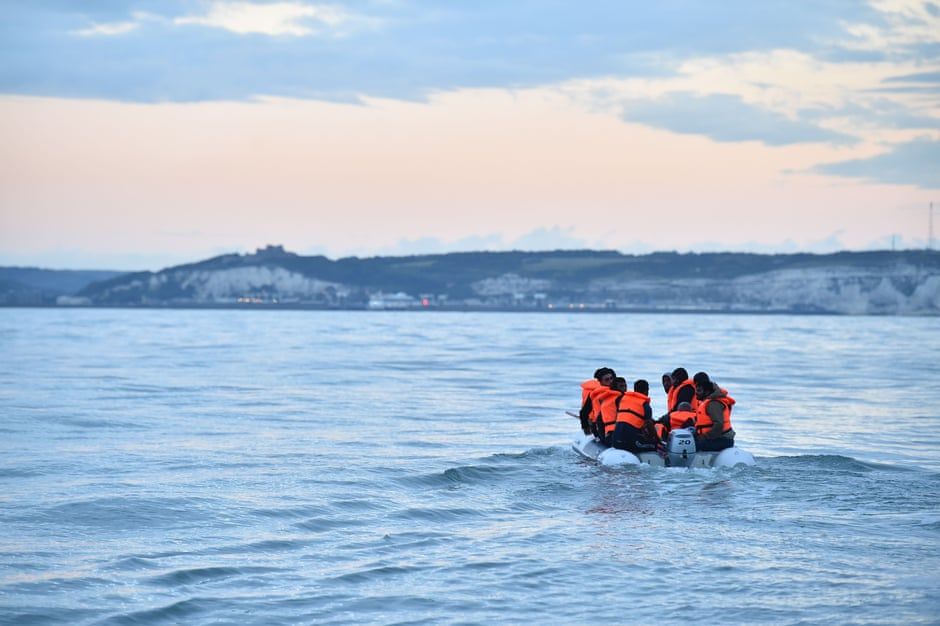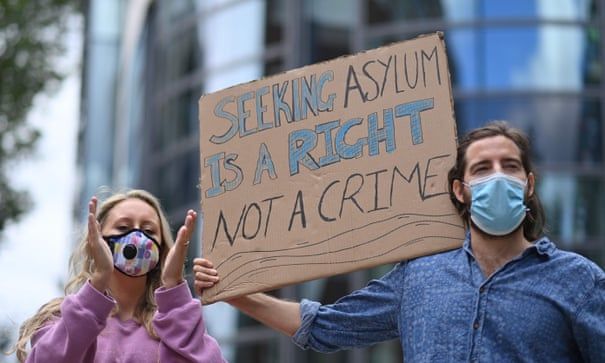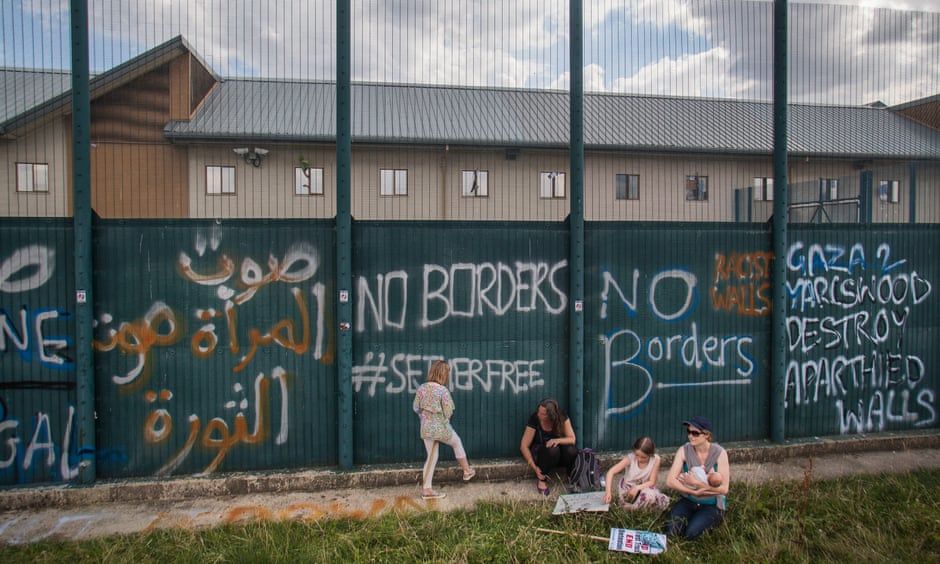On 12 August 2020 at 7.48am the first of a series of Home Office flights carrying asylum seekers left Stansted. This is the harrowing story of the hours before it took off and the anguish of those on board
At 7.15am, half an hour before charter flight Esparto 11 took off from Stansted airport, a detainee with a documented history of self-harm asked to use the plane’s bathroom. He was taken to the toilet by an escort working for the Home Office who held the door ajar with his foot and, after several minutes, peered inside to discover the detainee had slashed his wrist with a blade.
Pinning the man with his body weight to gain “control”, another officer squeezed into the bathroom and placed a handcuff on the wrist. According to an account written by officers, the handcuff was used to “[give] him pain”, a reference to a restraint technique which involves deliberately inflicting suffering to gain submission. In this case, most likely by twisting the cuff or pushing it into the wrist.
Esparto 11 left Stansted on 12 August last year, the first in an unprecedented programme of charters by a Home Office desperate to eject those who had recently arrived by crossing the Channel. Accompanied by scores of escorts, just 14 asylum seekers would be pressed on board the 295-seat aircraft. Bound for Toulouse and Frankfurt, Esparto 11 would dump its detainees thousands of miles from home. It is not known what happened to the man who self-harmed in the toilet.
What unfolds on such flights usually remains shrouded in mystery. Yet internal accounts written by Esparto 11’s escorts, seen by the Observer and Liberty Investigates, a journalism unit of the human rights organisation Liberty, along with testimony from detainees and statements from inspectors, offer a rare and disquieting insight into the programme.
While boarding the Airbus A330, officers allegedly inflicted force on six asylum seekers, including techniques that intentionally gave pain to two individuals deemed at risk of self-harm or suicide.
Witness accounts chronicle alleged threats of violence and suggest safeguarding processes to protect Esparto 11’s passengers fell by the wayside. One detainee who was “not resisting, just reluctant” to board a coach to the aircraft was forced to his knees and subjected to pain.
The material reveals other, deeper, issues. It sheds light on how senior Home Office officials authorised a secret – possibly unlawful policy – under cover of Covid-19 to expel vulnerable individuals. Introduced quietly after the March 2020 lockdown, the move meant they could rapidly deport asylum seekers who may have been trafficked and tortured.
All the passengers of Esparto 11 subsequently tracked down by Liberty Investigates and the Observer after being deported were from war-torn Sudan and South Sudan and claimed to be survivors of torture or trafficking.
The story of Esparto 11 also yields another fundamental question: why is the world’s fifth-richest economy so aggressively targeting a handful of at-risk people who arrived seeking sanctuary?
Nazeer* could see the fuzzy outline of Kent, but feared he would never reach it. Dangerously overloaded, the small inflatable dinghy was steadily filling with water. When they had left the French coast near Calais early on that June morning, Nazeer remembers how the craft heaved as he and 10 others boarded.
When they finally landed in mid-morning, they were swiftly picked up by police. Driven to the Yarl’s Wood an immigration holding facility, Nazeer was fingerprinted, his mobile confiscated and he was then interviewed. Nazeer is from Darfur in western Sudan, where non-Arabs like himself had suffered more than a decade of ethnic cleansing. In Sudan, he had been detainedby the authorities, beaten and then fled. In Libya, he was captured by traffickers. After months of unpaid labour he again escaped.
Omar*, another Esparto 11 passenger, is also from Darfur and, like Nazeer, would normally be eligible for refugee status in the UK. But the Home Office, noting both had been fingerprinted in other European countries, chose to deport them back to those states under an EU legal mechanism called the Dublin regulation.
The home secretary, Priti Patel, aware that Brexit spelled the end of the convention, was keen to return as many and as quickly as possible.
Yet a safeguard should have kept Omar and Nazeer in the UK. The Home Office’s initial asylum screening interview is designed to flag trafficking concerns. If identified and judged credible, their asylum claim may be significantly bolstered.
But Omar would slip through this safety net. The Home Office had secretly removed crucial questions linked to trafficking, which it later claimed had been to limit contact due to coronavirus. The Home Office says the individuals in this article were all asked questions designed to identify modern slavery. Yet Omar claims his interview was cut short as he tried to tell them his history. Documents charting Omar’s screening interview indicate it was shortened. Evaluating whether Omar suffered exploitation during his journey, officials wrote “no”.
 Migrants in a dinghy head towards the south coast of England last September after crossing from France.
Migrants in a dinghy head towards the south coast of England last September after crossing from France.
Nazeer and another Esparto 11 passenger – Peter* from South Sudan – also say they were denied an opportunity to fully describe the exploitation they endured.
When given details of Omar’s case, Maria Thomas, a solicitor at law firm Duncan Lewis, said it was highly likely his removal was unlawful. “Had the interview not been cut short, he would likely have been identified as a potential victim of trafficking and not removed.”
Instead, Omar and the others were arrested in late July, taken to Brook House detention centre and handed directions for their removal.
Home Office guidance stipulates they should have seen a solicitor. In early August, many of Esparto 11’s intended passengers were seeking legal help. Ultimately, 19 were granted a reprieve; three with emergency challenges close to the plane’s delayed departure at 7.48am.
Nazeer, Omar and Peter were not so fortunate. Nazeer learned his file couldn’t be examined until after the plane had left. A solicitor contacted Omar too late; the day before departure. Peter didn’t even speak to a lawyer. A Legal Aid Agency spokesperson said they were unable to verify anonymous claims but said the number of law firms providing specialist assistance had risen.
Nicola Burgess, legal director of the Joint Council for the Welfare of Immigrants, confirms its caseload at the time was overwhelming. “The demand far outstripped our ability to supply.” Regardless, the Home Office remained intent on deporting as many as feasible.
From August to December, it ran a concentrated schedule of 19 “Esparto” flights, prompting such distress among detainees that independent monitors wrote to Home Office ministers warning of “unnecessary, severe and continuing impact” equal to inhumane treatment.
 A demonstration outside the Home Office in August 2020 over the government’s deportation policies.
A demonstration outside the Home Office in August 2020 over the government’s deportation policies.
Meanwhile, Omar, Nazeer and Peter’s time at Brook House was increasingly fraught.
Three years after staff were caught “mocking, abusing and assaulting” people there, the mood last summer was dire. Independent observers described an atmosphere of “tension, fear and despair”. Self-harm was a daily occurrence – 44 incidents were recorded in August – with 32 detainees from an average population of 92 placed on constant supervision to prevent further harm.
Apparent failures to identify vulnerable asylum seekers were reported by observers from an Independent Monitoring Board (IMB). In mid-August, they noted the waiting time for GP appointments to assess detainees’ torture claims grew to 21 days.
Serco, which runs the centre, said the IMB “recognises that detainees are generally treated humanely” and found “generally positive” relationships between staff and residents.
But Emma Ginn, director of Medical Justice, said systems to protect the vulnerable were “clearly not working” last August. Even given Brook House’s disturbing history, it was the most distressing time at the centre she had known. “With charter flights every week, the likelihood of deportation was ever present, increasing our clients’ mental torment. Fellow detainees all around were self-harming. Brook House was a cauldron of despair.”
They began gathering after midnight at a squat office block near Brook House. By 1.30am, 86 escorts had been briefed.
Employed by private firm Mitie Care & Custody, which holds the Home Office contract for removal flights, they were warned that Esparto 11’s detainees were likely to be disruptive.
There was “no real lead from managers on the priority of detainee welfare”, noted an observer from HM Inspectorate of Prisons.
Meanwhile, Brook House staff began removing detainees from their rooms, a process they call “extraction”. Some wore riot gear. Omar was asleep when four officers roused him at 1.30am on 12 August. “But I have a doctor’s appointment on the 13th,” he told them, handing over a letter they looked at before leaving. As he waited, Omar remembers trembling with fear.
At 2am, between eight and 10 guards returned. As they took him away, Omar heard screams reverberating from nearby rooms.
Several detainees were “clearly distressed”, confirmed an inspector’s notes. At 3.25am, a young Iranian was brought down in wrist locks and handcuffed. A waist restraint belt was then fitted to him. An interpreter tried to ease his fears that Germany would send him back to Iran, but the sensitive conversation occurred in a rowdy reception area crammed with 22 people. An inspector from HM Inspectorate of Prisons described the scene as “intimidating”.
As removals were cancelled at the last-minute, communication occasionally suffered. At 5.15am, a detainee in a T-shirt and boxers was presented for handover with a bloody nose. Described as “calm and polite throughout”, the Kuwaiti’s nose had been injured during extraction while he repeatedly insisted his removal was cancelled, the escorts wrote. When they finally checked, it transpired he had been telling the truth. He was freed from restraints but suffered chest pains “caused by anxiety”, wrote an escort.
A senior escort wondered if the force used was too much. “Had this [cancellation] been sorted from the outset, force would not had [sic] been used,” they wrote. An internal inquiry found the use of force in this case was reasonable, necessary and proportionate.
Two coaches and nine secure vans were waiting. Omar says he pleaded with an interpreter to find a solicitor.
According to Omar, the interpreter urged him to comply. “There was a Sudanese before you who resisted … They almost killed him … You are going to be killed if you do not accept,” Omar alleges he was told. “I was grabbed from both sides and taken. I knew that if I resisted or I did not walk, then I would be forced into it, maybe beaten.”
Internal reports describe an incident the interpreter may have been referring to. Escorts’ accounts state that a Sudanese asylum seeker, Jamal*, resisted boarding a coach. An officer placed a handcuff on Jamal, giving “a clear instruction for him to let go, or he would feel pain in his wrist”.
The escort added that Jamal then “thrashed his head” and tried to bite them. The officer then used the handcuff to apply pain. Jamal was “forced to his knees”, his arms restrained, and taken to a van. Guidance states that verbal reasoning and de-escalation strategies are used before force, but Jamal speaks little English and it is unclear if interpreters were present or if he understood the escort’s “clear instruction”. Jamal declined to be interviewed for the investigation saying he was too traumatised.
Joanne Caffrey, who was a police officer for 24 years and is an expert witness in use of force, said regardless of language barriers, stress causes auditory exclusion. “It’s as though you put your head in a bucket of water and somebody’s shouting commands at you.”
Pain-inducing tactics can also be risky. While waiting at Stansted to board Esparto 11, another passenger with a history of self-harm was discovered to have a blade in his mouth.
Escorts ordered him to spit it out; he refused. An officer applied the mandibular angle technique, which involves pressing down on a nerve behind the ear. If performed incorrectly, the move can cause paralysis or death, said Caffrey. The detainee also risked swallowing the blade, she said.
Reaching the runway, the detainees were summoned by their number. Nazeer was willing to board peacefully, he claims. “But… one person grabbed me from my right arm, the other my left, and somebody was pushing me in the back to get me to climb the stairs. It was humiliating and unnecessary,” he says. Escorts held the arms of all detainees who boarded on foot.
Half were in some form of restraint device. Jamal was one of two detainees carried onto Esparto 11. When boarding was complete, the atmosphere was harrowing, says Peter. “They were detained and handcuffed, some were crying,” he said. He didn’t witness other Brook House removals but when he later met them said: “I saw that they were in pain.”
Prison inspectorate officials are not routinely present to observe charter flights. Even when they are, they may miss the most distressing events. Esparto 11’s inspector “did not observe” the three incidents that involved applying pain through handcuffs, including the bathroom episode, and “[could not] judge the operational requirement”.
Yet the escort’s own written internal reports raise, according to Caffrey, searching questions. Of 25 forms completed to detail six incidents, the same box was ticked to indicate force was required because of “non-compliance”.
One stated “all efforts to de-escalate situation were made through verbal reasoning”, without being specific.
Officers wrote variations on “all force used and witnessed was necessary, reasonable and proportionate” nine separate times.
This made the documents seem like a “tick box exercise” to justify premeditated force, added Caffrey. Based on the documents alone it was impossible for her to conclude whether force deployed during Esparto 11 was lawful. “Just because there’s a right to use force doesn’t mean it’s right to keep doing it,” she added.
A statement from the Home Office said it takes the health and wellbeing of detainees extremely seriously and undertakes individual risk assessments before all returns. It added: “On occasion, people with no right to be in the UK go to extreme lengths to prevent their removal by attempting to cause physical harm to officers or themselves. In these instances, force will be used sparingly as a last resort for their own and others’ protection.”
Burgess described such actions against Esparto 11’s detainees as a violation of their rights that risked fresh trauma. They were treated as a “political football”, she said, and their experience was not unique. “The story of Esparto 11 is a paradigm of the UK’s inhumane asylum system,” she said.
Mitie said that it followed strict government guidelines to ensure detainee safety. “All officers are specially trained in line with Home Office procedures on the use of restraint. This includes a focus on de-escalation techniques to ensure force is only applied when absolutely necessary.”
Yet Alison Thewliss MP, chair of the parliamentary group on immigration detention, believes the Esparto 11 revelations are so grave Patel “should consider her position in light of these shocking reports”.
Thewliss added: “This behaviour is barbaric and has no place in decent society. It denies these people access to legal representation, it disregards their vulnerabilities, and it deems this type of force proportionate in order to remove them.”
 The controversial Yarl’s Wood detention centre in Bedfordshire.
The controversial Yarl’s Wood detention centre in Bedfordshire.
Drenched in rain, Omar gestured to the wooden crate and tarpaulin he sleeps on.
Months after Esparto 11, Omar was tracked down to a European city he doesn’t wish to be identified because he fears another removal.
By rejecting all asylum claims made by people who cross the Channel, Patel wants future arrivals rapidly removed to any country that will accept them. This central ambition could make flights like Esparto 11 the norm. Experts brand her plans unworkable, incoherent and cruel.
The Home Office is unrepentant. When independent monitors wrote to minister Chris Philp last October warning of “inhumane treatment” of detainees, he responded bullishly.
“The UK has a long and proud history of providing protection to those who need it,” wrote Philp, and the government “[stands] by our obligations to safeguard the most vulnerable people fleeing oppression, persecution and tyranny.”
When told of this, a note of irritation creeps into Omar’s voice. “I was persecuted and fleeing my country [and] was not offered any protection,” he says, before appearing to well up.
“To be allowed to stay somewhere that I can live like a normal human being, to establish a life, to have a family … Is that too much to ask?”















